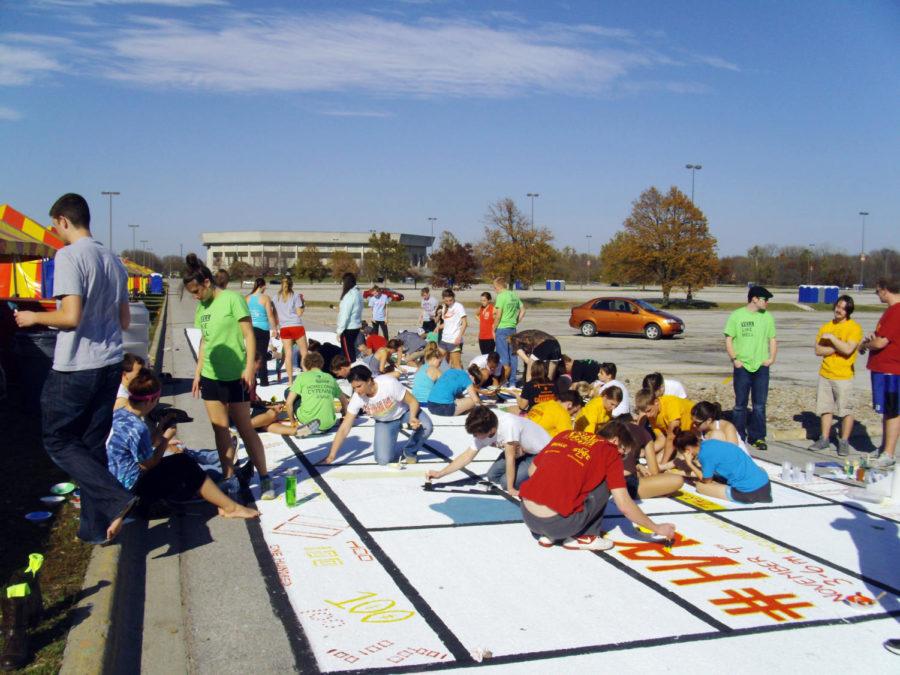Cytennial Homecoming keeps, adds to past traditions
Photo: Michael Still/Iowa State Daily
Members of the greek community paint Victory Lane in front of Jack Trice Stadium on Sunday, Oct. 21, as part of the Cytennial Celebration for the 100th Homecoming at Iowa State.
October 22, 2012
The 100 years of celebration and tradition comes to a culmination with this year’s Cytennial Homecoming.
Samuel Beyer, an ISU professor in 1912, brought the first Homecoming to Iowa State as a celebration of alumni. The celebration would be the same week as the football game against rival University of Iowa. The football team lost to Iowa 20-7 in this first game and did not win a homecoming game until 1917 against Kansas State.
With more than 150 alumni returning that first year, the event was labeled a success and the tradition continued. Iowa State is known as one of the first schools to hold such an event centered on pride and tradition.
The first ISU Homecoming pep rally was in 1912 in the auditorium in Curtiss Hall, which is a tradition that continues today. The pep rally evolved into a barbecue called “Hamburgers for Homecoming” in 1930 with approximately 3,000 in attendance. Pep rally traditions that have lasted throughout the years include football coaches and players giving speeches, Yell Like Hell finals, and performances from the ISU Dance Team, cheerleaders and Cy.
Les Laske, 47, is an alumnus who has revisited Homecoming multiple times since his 1986 graduation. Laske was part of the Phi Kappa Theta fraternity and distinctly remembers his favorite parts of Homecoming.
“The barbecues at the [fraternity’s] house, the tailgating and the football games were always my fondest parts of Homecoming,” Laske said. “I always enjoy coming back to see the students’ love for the school. The atmosphere of campus is unmatched.”
Banner contests, food on campus and lawn displays are a few of the traditions that help to create this atmosphere. Lawn displays are one of the few traditions that have been key to Homecoming events from the very first year.
The first lawn display appeared during the first ISU Homecoming in 1912. Engineering students created an electric sign, 55 feet long and 20 feet high, that read “Beat Iowa, Eat Iowa.”
The displays moved from the streets of Ames, to the campus residence, to a competition between houses. The popularity decreased over the next few years but was made popular again by one fraternity in an effort to keep the tradition alive. This effort led to what is now the competition between greek pairings, judged by ISU faculty and alumni.
Beginning in 1912, the Homecoming dance was one of the most festive and anticipated events in the 1930s. Here, more than 4,000 students danced the night away while listening to live bands, including Louis Armstrong in 1950, and announcements of who won Homecoming Queen and the lawn display winner.
Another lost tradition is the class break, which started the first year when the ISU president canceled classes Friday and Saturday of that year’s homecoming. Throughout the years, this tradition was lost and brought back various years by student demand until it disappeared completely.
Through all of these traditions and celebrations, a consistent effort is to bring alumni back to their alma mater.
In 1932, the Alumni Association was created for charitable and educational purposes. Today, the Alumni Center serves as a “home away from home” for members of the ISU family.
Kurt Beyer, assistant director for student programs and student alumni leadership counselor, is entering this year’s Homecoming busier than he has ever been in his six years working with the event.
“Every year, Homecoming gets bigger and better,” Beyer said. “I can definitely say this is the biggest year yet.”

















